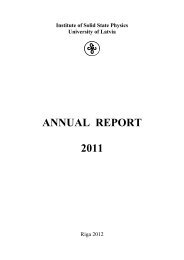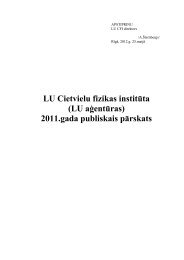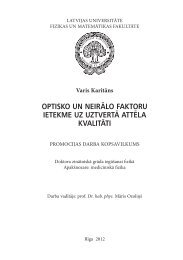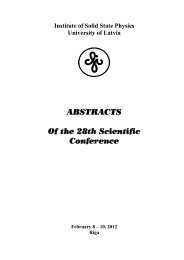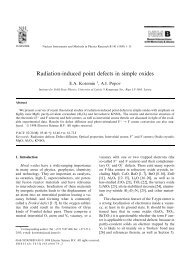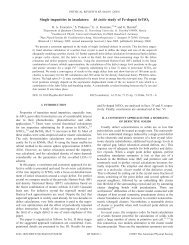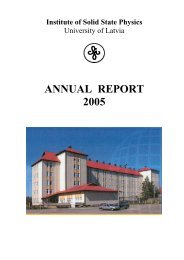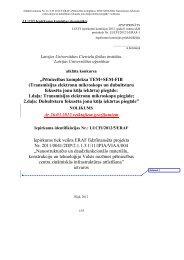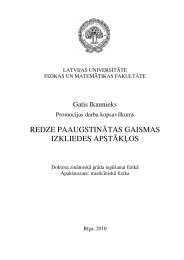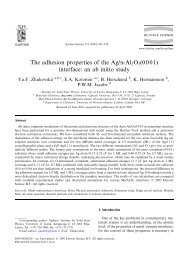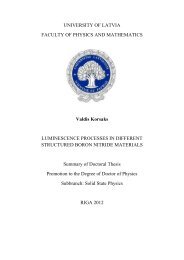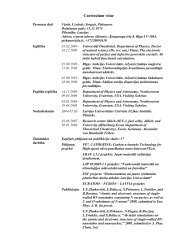Annual Report 2012 - Latvijas Universitātes Cietvielu fizikas institūts
Annual Report 2012 - Latvijas Universitātes Cietvielu fizikas institūts
Annual Report 2012 - Latvijas Universitātes Cietvielu fizikas institūts
You also want an ePaper? Increase the reach of your titles
YUMPU automatically turns print PDFs into web optimized ePapers that Google loves.
them is with UV band at 6 eV, appears at low temperatures and could be excited only in<br />
tunnelling recombination process between pairs [AlO 4 - Meo], where Me o is an alkali<br />
ion captured an electron and a hole remains on aluminium tetrahedron. Another<br />
luminescence with band at 3.4 eV is also luminescence of complexes [AlO 4 /Me+],<br />
which behaviour is similar to the luminescence of alkali alumo-silicate glass. The third<br />
luminescence with band at 3 eV could be observed mainly in natural α-quartz, bright at<br />
temperatures below 200 K and is interpreted as STE-like luminescence at alumo-silicate<br />
clasters. The exchange of alkali ions to noble ions of copper of silver reduces original<br />
luminescence of alumo – alkali complexes and luminescence of noble ions appears. The<br />
main band of copper related luminescence is at 3.4 eV and that of silver is at 4.75 eV,<br />
both could be observed up to 500 K. their nature could be well described in terms of<br />
intra-ions transition. Exchange of noble ions back to alkali ions renews initial<br />
luminescence of the samples.<br />
LUMINESCENCE OF UNFUSED F-DOPED 95%SiO 2 -5%GeO 2 AMORPHOUS<br />
FILMS FABRICATED BY SPCVD. ABSENCE OF GeODC(I) DEFECTS<br />
A.N. Trukhin 1 , K.M. Golant 2 , J. Teteris 1<br />
1 University of Latvia, Solid State Physics Institute, LV-1063, Riga, Latvia<br />
2 Kotel’nikov Institute of Radio-engineering and Electronics of RAS,<br />
125009 Moscow, Russia<br />
We have studied influence of fluorine on germanium oxygen deficient luminescence<br />
center (GeODC) in films (~100 µm) produced by the surface-plasma chemical vapor<br />
deposition (SPCVD). Two kinds of samples were studied: a sample with “high” 4.2<br />
wt.% of F concentration of fluorine and a sample with “low” 0.5 wt. % of F<br />
concentration of fluorine. Main feature of the samples difference corresponds to<br />
difference in detection of GeODC luminescence. For the case of “high” level of fluorine<br />
a “normal” GeODC or so call GeODC(II) or twofold coordinated germanium is<br />
observable. That there is absorption band at 5 eV where luminescence of GeODC is<br />
excited. The effect of “high” fluorine thermally non treated sample is similar to the case<br />
of thermally treated germanium containing SPCVD sample without fluorine studied<br />
previously. So, we conclude that effect of “high” fluorine sample is related to<br />
diminishing of glass softening temperature. In the case of low fluorine concentration<br />
corresponds to the case of thermally non-treated SPCVD sample then we conclude that<br />
“low” fluorine case insufficiently diminishes softening temperature. the absorption band<br />
at 5 eV is not well expressed, and however luminescence of GeODC is observed there<br />
under 248 nm excimer laser (KrF), it intensity is much lower than in the case of high<br />
fluorine concentration. Most significant difference is observed for excitation with higher<br />
than 5 eV photons – that is excitation with 193 nm (ArF) and 157 nm (F2) of excimer<br />
lasers. The decay kinetics of luminescence for observed under these conditions is very<br />
different from usual GeODC, however luminescence bands positions are close to usual<br />
GeODC. Noticeable effect under both last cases of excitation is luminescence intensity<br />
growth during long time excitation (half an hour and more), therefore it was concluded<br />
that GeODC are produced by this irradiation.<br />
In the case of “high” concentration of fluorine the yield of GeODC luminescence excited<br />
with 157 nm photons (F2 excimer laser) still is high. Therefore it was concluded that<br />
competitive absorption of SiODC(I) with 7.6 eV absorption band is diminished by<br />
fluorine. High yield of luminescence shows that analogous to the SiODC(I) a GeODC(I)<br />
does not exist. It is known from literature that SiODC(I) of pure silica glass could be<br />
passivated with fluorine with strong diminishing of famous 7.6 eV absorption band of<br />
oxygen deficient pure silica glass.<br />
94



